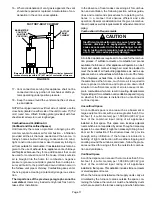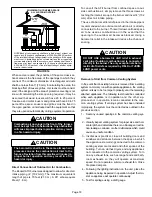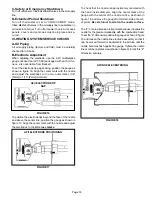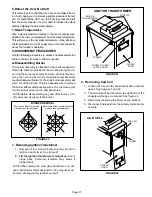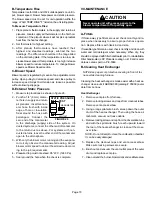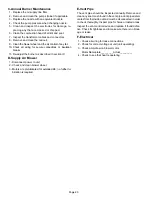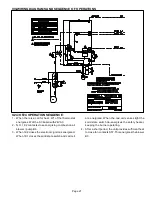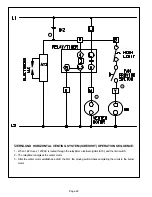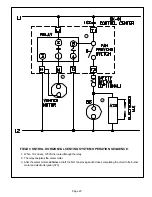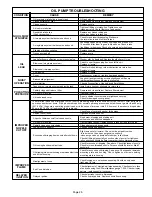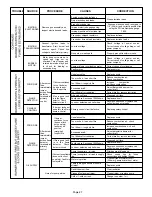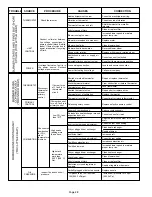
Page 25
CONDITION
CAUSE
REMEDY
OIL PUMP TROUBLESHOOTING
NO OIL FLOW
AT NOZZLE
OIL
LEAK
NOISY
OPERATION
PULSATING
PRESSURE
IMPROPER
NOZZLE
CUTOFF
IMPROPER
FLAME
DELAYED
IGNITION
Oil level below intake line in supply tank.
Fill tank with oil.
Clogged strainer of filter.
Remove and clean strainer. Replace filter element.
Clogged nozzle.
Replace nozzle.
Air leak in intake line.
Tighten all fittings in intake line. Tighten unused
intake port plug. Check filter cover and gasket.
Restricted intake line
(High vacuum line.)
Replace any kinked tubing and
check any valves in intake line.
A two-pipe system that becomes air bound.
Check for and insert bypass plug. Make sure
the return line is below oil level in tank.
A single-pipe system that becomes air bound.
Loosen gauge port plug or easy flow valve and bleed oil for
15 seconds after foam is gone in bleed hose. Check intake
line fittings for tightness. Check all pump plugs for tightness.
Slipping or broken coupling.
Replace coupling.
Frozen pump shaft.
Replace pump.
Loose plugs or fittings.
Seal with good quality thread sealer. Retighten.
Leak at pressure adjusting screw or nozzle plug.
Washer may be damaged. Replace the washer or O-ring.
Blown seal (single-pipe system.)
Check to see if bypass plug has been left in unit.
Replace oil pump.
Blown seal (two-pipe system.)
Check for kinked tubing or other obstructions in return line.
Replace oil pump.
Seal leaking.
Replace oil pump.
Cover.
Tighten cover screws or replace damaged gasket.
Bad coupling alignment.
Loosen oil pump mounting screws slightly and shift pump
in different positions until noise is eliminated.
Air in inlet line.
Check all connections. Use only good flare fittings.
Tank hum on two-pipe system and inside tank.
Install return line hum eliminator in return line.
Partially clogged strainer or filter.
Remove and clean strainer. Replace filter element.
Air leak in intake line.
Tighten all fittings.
Air leak around cover.
Be sure strainer cover screws are tightened securely.
Check for damaged cover gasket.
To determine the cause of improper cutoff, insert a pressure gauge in the nozzle port of the fuel unit. After a minute of
operation shut burner down. If the pressure drops from normal operating pressure and stabilizes at greater than 80 psig
(551.6 kPa), the pump is operating properly and air is the cause of improper cutoff. If, however, the pressure drops below
80 psig (551.6 kPa) oil pump should be replaced.
Filter leaks.
Check face of cover and gasket for damage.
Strainer cover loose.
Tighten 4 screws on cover.
Air pocket between cutoff valve and nozzle.
Run burner, stopping and starting unit,
until smoke and after-fire disappears.
Air leak in intake line.
Tighten intake fittings. Tighten unused intake port and return plug.
Partially clogged nozzle strainer.
Clean strainer or change nozzle.
Leak at nozzle adaptor.
Change nozzle and adaptor.
Excessive oil dripping from nozzle after shutdown.
Slight amount of oil normal. All air must be purged from line.
-turn burner on, then open purge valve on pump.
-close purge valve on pump before burner is shut down.
Check all fittings (especially on suction side of pump) for tightness.
-all connections should be flare type rather than compression type.
Oil running back down blast tube.
Check for excess oil dripping. See above. Check tightness of nozzle.
Check for cross-threaded nozzle. Furnace should be level or tilted 3
backward.
Oil dripping into burner housing or between blast tube
and burner housing.
Check for excessive oil dripping. See above. Check gasket between
mounting plate and housing. Check tightness of screws holding
mounting plate to housing.
Misalignment of cone.
Check locking nut on electrode assembly. Should be only hand
tight plus 1/4 turn.
End Cone distortion.
Check alignment of electrode/oil pipe assembly. Check nozzle to face
of end cone using the AFII multipurpose gauge T-500. Check oil spray
pattern - replace nozzle if necessary.
Delayed ignition.
Check electrode to nozzle dimension.
Check oil spray pattern. Replace nozzle if necessary.

